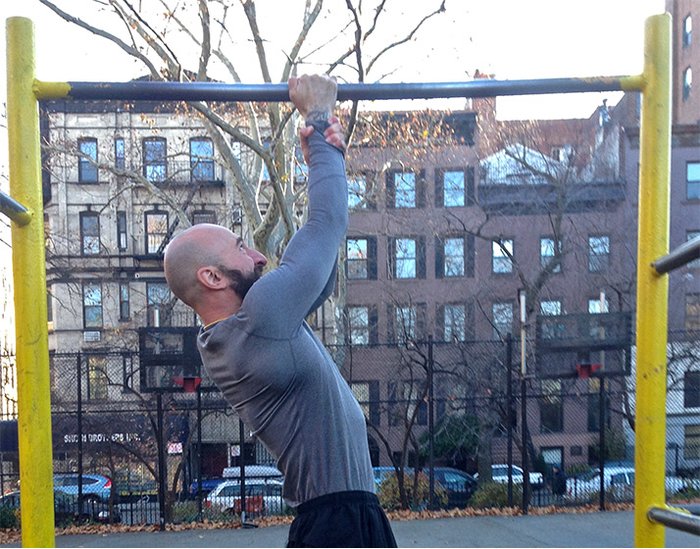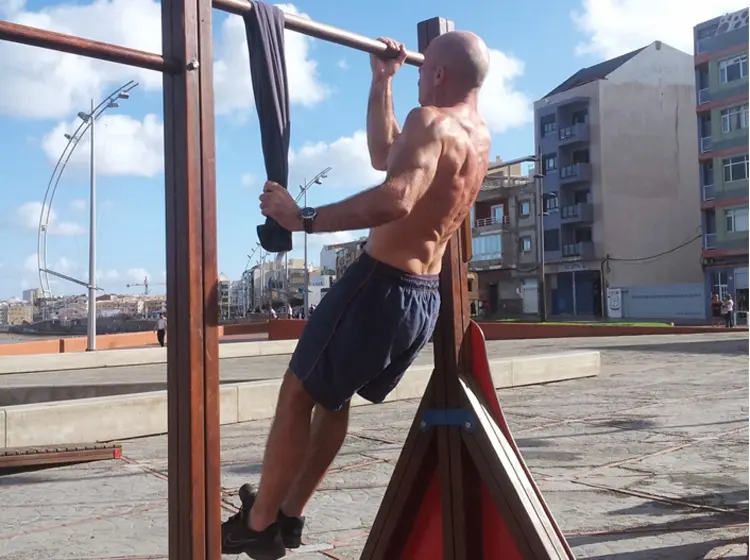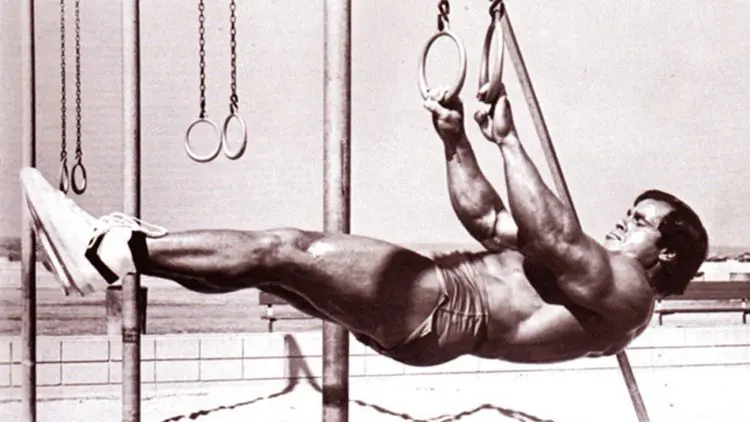Pull-ups and chin-ups, which are largely interchangeable, are staples of calisthenics training. Both exercises work your upper back and biceps. To do either of these exercises, you need to be strong enough to lift your entire body weight using just your arms. This is no mean feat, and a lot of people are unable to do even one rep.
That said, with time and training, most exercisers should be able to work up to doing this exercise. After doing one rep, your next goal should be pumping out five. From there, ten reps make a good target.
But what should you do once you can do ten perfect pull-ups or chin-ups? You could focus on cranking out more reps or start adding weight to make things more challenging. In truth, both of these progressions should keep your back and biceps growing.
Alternatively, or even simultaneously if you wish, you could start working on doing one-arm pull-ups.
Not everyone is built to do one-arm pull-ups, and for some people, they’re an impossible dream, but you won’t know unless you try.
In this article, we explain how to do this ultra-challenging exercise and reveal the best variations and alternatives you can use to train for them.
Level Up Your Fitness: Join our 💪 strong community in Fitness Volt Newsletter. Get daily inspiration, expert-backed workouts, nutrition tips, the latest in strength sports, and the support you need to reach your goals. Subscribe for free!
One-Arm Pull-Up Anatomy 101
If you already do regular pull-ups, you probably already know what muscles that one-arm pull-ups work. That said, it won’t hurt to refresh your anatomical knowledge!
Latissimus dorsi – known as the lats for short, this is the agonist or prime mover during one-arm pull-ups. Located on the side of your upper back, the lats connect your arms to your torso and are responsible for shoulder joint adduction and extension. Well-developed lats look a lot like wings and are visible from the front and the back, contributing to your V-taper.
Biceps brachii – located on the front of your upper arm, the biceps are probably the most well-known muscle in the human body. The biceps flex your elbow and supinate (rotate) your forearm.
Trapezius – the traps are the large diamond-shaped muscle that covers most of your upper back. There are three sets of fibers, making the upper, middle, and lower traps. The lower traps hold your shoulders down during one-arm pull-ups, while your middle traps pull your shoulders back. This provides a stable platform for your other muscles to work from. The upper traps are not especially active during this exercise.
Forearms – one-arm pull-ups require and develop a vice-like grip, and your forearms are your gripping muscles. There are several forearm flexor muscles, most of which have long and complicated Latin names, and almost all of them are involved in one-arm pull-ups.
Core – one-arm pull-ups are pretty core-centric. The muscles of your midsection will have to work hard to stabilize your lumbar spine and stop your legs from swinging. The muscles of your core include rectus abdominis, transverse abdominus, obliques, and erector spinae.
How to Do One-Arm Pull-Ups
For many people, this section of our guide will be redundant. Some of you reading this will not be ready to try this exercise yet. Before attempting one-arm pull-ups, you should be able to:
- Do a single-arm dead hang for 20-30 seconds
- Be able to do 15 and preferably 20 regular pull-ups or chin-ups
- Be able to do a few weighted pull-ups or chin-ups with at least 25% of your body weight
If you can’t do these things, you probably aren’t ready to try one-arm pull-ups yet. Don’t worry, though; we’ve got several variations and alternatives you can use to develop the strength you need to do one-arm pull-ups.
- Using an overhand, underhand, or neutral grip, hang from your pull-up bar with your body straight and core braced. Keep your non-working arm either down by your legs or out to the side as preferred.
- Initiate the movement by depressing your shoulder girdle, which means pulling your shoulder down. Depress both shoulders but emphasize the side you are working on. This engages your lats.
- Bend your arm and pull your chin up toward the bar. Keep your upper arm close to your body to maximize leverage and movement efficiency. Try not to swing or kick your legs. However, a little kipping may be necessary to complete your rep.
- Smoothly and under control, extend your elbows and lower yourself back down. Don’t just drop, as doing so will shock-load your elbow and shoulder joint.
- Try to do the same number of reps on each arm but also remember that it’s pretty common to have one arm stronger than the other.
One-arm pull-ups are somewhat open to interpretation, and many of the people that can do them use slightly different techniques. If you watch a few one-arm pull-up YouTube videos, you’ll see some people pulling the same shoulder up to the bar while others pull the opposite shoulder up. Some stay square to the bar, while others are at right angles.
Ultimately, it’s up to you to find the position and technique that works best for you. Experiment to discover your one-arm pull-up power zone.
One-Arm Pull-Up Variations and Alternatives
Chances are that you’ve tried one-arm pull-ups and failed. That’s okay – very few people can do this exercise the first time out. In fact, it may take months or even years to develop the strength you need to pull this exercise off.
Use the following variations and alternatives to build the strength you need to do one-arm pull-ups for real.
1. One-arm lat pulldowns
The one-arm lat pulldown is a very pale imitation of one-arm pull-ups, but it’s a decent place to start if you are still working on building your basic pull-up strength. Use this exercise to develop your single-arm strength, lateral core stability, and get into the habit of initiating each rep by depressing your shoulder girdle.
This is also a good way to warm up before starting your one-arm pull-up workout. Experiment with underhand, overhand, and neutral grips to see which feels strongest.
Learn how to do one-arm lat pulldowns here.
2. One-arm flex hang
The one-arm flex hang is an isometric or static exercise. You are much stronger isometrically than you are concentrically or eccentrically. This means you can usually hold more weight than you can lift or lower. However, isometric training can help increase concentric and eccentric strength. Use this exercise to start laying the foundation for one-arm pull-ups.
How to do it:
- Place a chair or bench under your pull-up bar and stand on it. Hold the bar with your preferred grip.
- With your arm bent and your core braced, lift your feet off your platform.
- Hold for as long as possible and then rest.
- Do holds at the top of the movement and one-third and two-thirds down to ensure you develop strength through the entire range of motion.
- Train both arms equally.
3. Negative one-arm pull-ups
You are stronger eccentrically than you are concentrically. In other words, you can lower more weight than you can lift. This is why a lot of lifters do negative training. Negatives allow you to train with heavier than normal weights. Negative one-arm pull-ups are a great way to develop the strength necessary to do regular one-arm pull-ups.
How to do it:
- Place a chair or bench under your pull-up bar and stand on it. Hold the bar with your preferred grip.
- With your arm bent and your core braced, lift your feet off your platform.
- Smoothly extend your arm and lower yourself down under control until your elbow is straight.
- Climb back up and repeat.
- Do several reps per arm and then switch sides or alternate arms as preferred. Stop your set when you are no longer able to control your descent.
4. One-arm pull-ups with your hand around the wrist
Level Up Your Fitness: Join our 💪 strong community in Fitness Volt Newsletter. Get daily inspiration, expert-backed workouts, nutrition tips, the latest in strength sports, and the support you need to reach your goals. Subscribe for free!
Grip is an essential part of one-arm pull-ups. This exercise allows you to use both arms to pull yourself up, but you’ll only have one hand on the bar. This variation is an excellent way to build your grip and also emphasizes one arm at a time, making it a valuable steppingstone to real one-arm pull-ups.
How to do it:
- Using one arm, hold your pull-up bar with your preferred underhand, overhand, or neutral grip. Hold your wrist with the other arm. Brace your legs and lift your feet off the floor.
- Using both arms, pull your chin up to the bar.
- Come down under control and repeat.
- Do the same number of reps on both sides.
5. Self-assisted one-arm pull-ups
For this one-arm pull-up variation, you are going to use your non-working arm for assistance, taking weight off the arm you are training. As you get stronger, you should give yourself less assistance until, eventually, you can do one-arm pull-ups unaided.
How to do it:
- Tie a rope, towel, or strong resistance band to your pull-up bar, so that it hangs down next to you.
- Grab the pull-up bar with your preferred overhand, underhand, or neutral grip.
- Hold the rope/towel, band with the other hand, about 12-18 inches down from the top.
- Mainly using the hand on the bar, pull yourself up while using your other arm for assistance.
- Descend slowly and repeat.
- The lower you place your assisting hand, the less you’ll be able to use it.
6. Band-assisted one-arm pull-ups
Band-assisted one-arm pull-ups help support some of your body weight to make this demanding unilateral exercise more manageable. The assistance is more noticeable at the start of your rep when your arm is straight and the band is stretched, and then eases off near the top of the rep. This force curve matches the changes in leverage, so assistance is greatest where you are weakest and least where you are strongest.
How to do it:
- Attach a strong, loop-type resistance band to your pull-up bar. Grab the bar with one hand and then stand or kneel in the band.
- Using the band for assistance, bend your arm and pull your chin up to the bar.
- Descend under control and repeat.
7. Single-arm body rows
Like pull-ups and chin-ups, body rows are a very effective bodyweight upper back and biceps exercise. Usually done with two hands, there is no reason not to use single-arm body rows to increase your lat and arm strength.
How to do it:
- Sit below your bar and hold it using a single, overhand grip. Straighten your legs so, with your arm extended, your body forms a straight line.
- Bend your arm and pull your chest up to the bar.
- Extend your arm and repeat.
- The higher the bar and the more upright you are, the easier this exercise will be.
- This exercise can be done using a bar in a squat rack, a Smith machine, or a suspension trainer, such as a TRX.
8. Front lever raises
Like one-arm pull-ups, front lever raises are a tough-as-nails calisthenic upper body exercise. But, unlike pull-ups, they feature more lat activation, and your arms are much less involved. Use this exercise to build better lat strength, increase your lat mind-muscle connection, and train your lats while giving your hard-working biceps and elbows a welcome break.
Learn how to do front lever raises here.
9. Jump start one-arm pull-ups
The hardest part of most exercises is getting moving from stationary. This is called overcoming the moment of inertia. One way to get around this problem is with a jump start. Using your legs for assistance will help get you moving and power you through the first and most difficult part of your rep.
How to do it:
- Using a bar that’s just 12-18 inches above your head, hold it using your preferred underhand, overhand, or neutral grip.
- Bend your knees slightly and then jump upward while simultaneously bending your arm. Pull your chin up and over the bar.
- Descend slowly and with control, and then repeat.
One-Arm Pull-Up Tips
Get more from one-arm pull-ups and improve your chances of doing them at all with these handy tips!
Warm-up thoroughly – make no mistake; one-arm pull-ups are a very strenuous exercise. They’re tough on your elbows and shoulders and could cause injury. Prepare your body for your coming workout by warming up thoroughly.
Do some light cardio followed by dynamic mobility and flexibility exercises and muscle activation drills too. Shoulder depressions while hanging from a pull-up bar and regular pull-ups are both good options, as are single-arm lat pulldowns.
Grease the groove – while one-arm pull-ups are a test of lat and biceps strength, they are also a test of skill. The best way to develop any skill is by practicing. Get better at one-arm pull-ups faster by doing them daily. This is called greasing the groove.
With GTG training, you do lots of low-intensity sets spread throughout your day. This allows you to accumulate a high volume of reps without too much fatigue.
Read more about grease the groove training here.
Mix it up – doing the same exercise over and over will soon lead to progress plateaus and overuse injuries. Avoid such problems by using several of the variations outlined above. For example, you could do band-assisted one-arm pull-ups one day, self-assisted one-arm pull-ups the next, and negative one-arm pull-ups the day after that.
Lose weight – carrying extra weight will make one-arm pull-ups even harder than they already are. If you are carrying some unwanted blubber, now is the time to lose it. Start doing a little more cardio, reduce your calorie intake, and start eating clean to shed fat and make one-arm pull-ups a little easier.
Persevere – even very strong people struggle to do one-arm pull-ups, so don’t worry if you can’t do them right away. It may take weeks, months, or even years before you master this exercise.
The good news is that training for one-arm pull-ups should have a knock-on effect on your arm and back strength and size, and you’ll definitely get better at regular pull-ups and chin-ups.
Prepare for the long haul, commit to the process, and persevere. One way or another, you WILL be rewarded!
Wrapping Up
One-arm pull-ups are one of the most advanced bodyweight exercises around. That’s why not many people can do them. Even very strong exercisers are humbled by this movement, and some never master it.
However, if genetics are on your side and you’re prepared to work hard and consistently, you may eventually be able to pull off this impressive feat of strength. It might take a while but, with perseverance and dedication, it could be within your grasp.
Use the information in this guide to train for one-arm pull-ups. Even if you don’t reach this holy grail of calisthenic exercises, your biceps and lats will get bigger and stronger along the way.
Interested in measuring your progress? Check out our strength standards for Pull Ups, Clean, Chin Ups, and more.











